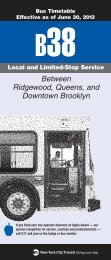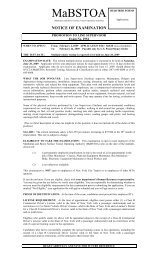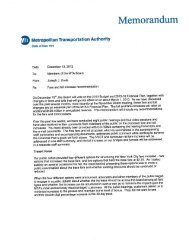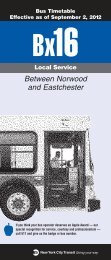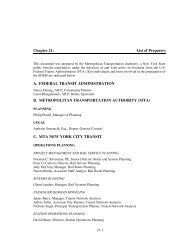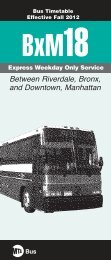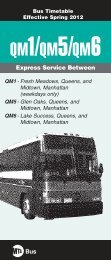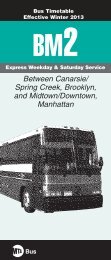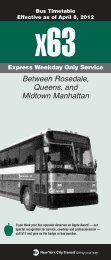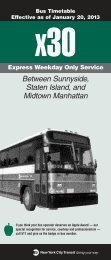Greening Mass Transit & Metro Regions: The Final Report - MTA
Greening Mass Transit & Metro Regions: The Final Report - MTA
Greening Mass Transit & Metro Regions: The Final Report - MTA
Create successful ePaper yourself
Turn your PDF publications into a flip-book with our unique Google optimized e-Paper software.
Smart Growth/TOD<br />
Land use planning, transit access, and transit-oriented development<br />
Smart growth and transit-oriented development (TOD) go<br />
to the heart of the <strong>MTA</strong>’s mission. <strong>The</strong>y also represent the<br />
<strong>MTA</strong>’s greatest contribution to regional sustainability. By<br />
expanding the reach and deepening the localization of its<br />
transit network, the <strong>MTA</strong> reduces the fossil-fuel consumption<br />
and the carbon footprint of the entire region. By enabling<br />
more clustered, transit-rich development, the <strong>MTA</strong> helps<br />
to mitigate the underlying causes of global warming while<br />
promoting more livable, sustainable communities.<br />
Emerging trends make this the right time for the <strong>MTA</strong> to<br />
redouble its TOD efforts. <strong>The</strong> <strong>MTA</strong>’s “Strategic Regional<br />
Review” projects a population increase in the service area<br />
of over 4 million by 2030. <strong>The</strong> Commission urges that the<br />
<strong>MTA</strong> work diligently with communities, developers, and<br />
government officials to direct this growth away from autodependent<br />
sprawl toward transit-centered development.<br />
<strong>The</strong> <strong>MTA</strong> should seek to capture two-thirds of this new<br />
growth. That is, the <strong>MTA</strong> transit network should strive to<br />
attract two-thirds of the additional vehicles miles traveled<br />
(VMTs) due to new growth between now and 2030; and<br />
the <strong>MTA</strong> should encourage public and private planners to<br />
cluster two-thirds of the new development within a quartermile<br />
to a half-mile of <strong>MTA</strong> transit access.<br />
Recessionary economic trends also argue for expanded<br />
TOD initiatives. <strong>The</strong> Commission recommends that the<br />
<strong>MTA</strong> strengthen all efforts to promote the environmental,<br />
economic, and lifestyle benefits of transit access to local<br />
communities, developers, legislators, and officials. Numerous<br />
studies, including those cited in this report, prove the positive<br />
correlation between TOD and property values. Local transit<br />
access widens employment opportunities, links commercial<br />
centers, reduces family fuel bills and helps create the livable,<br />
walkable communities that homebuyers increasingly seek.<br />
<strong>The</strong> Commission sees a prime opportunity for the <strong>MTA</strong><br />
to take ownership of what many refer to as the “last mile”<br />
problem. <strong>The</strong> <strong>MTA</strong> should apply its resources and regional<br />
overview to eliminate the remaining home-to-destination<br />
gaps in the regional transit network through feeder/distributor<br />
corridors, which includes feeder service (home to station),<br />
distributor service (station to employment centers), lightrail,<br />
bus rapid transit, shuttle service, bike routes and bike<br />
facilities, and other transit modes.<br />
Left: <strong>Metro</strong>-North is leading the Be in Beacon project that is<br />
encouraging transit oriented development near Beacon Station<br />
through a partnership with the State of New York, Dutchess County,<br />
the City of Beacon, and other stakeholders<br />
Public policy trends also look favorable for expanded<br />
Smart Growth and TOD initiatives. From the Obama<br />
Administration to state and local governments, a renewed<br />
emphasis on economic stimulus, infrastructure, and sustainability<br />
all play to the <strong>MTA</strong>’s strengths. In pursuing TOD<br />
projects with public officials and local stakeholders, the<br />
<strong>MTA</strong> brings many powerful tools and incentives to the<br />
table. <strong>The</strong> <strong>MTA</strong> now has a portfolio of successful TOD<br />
projects, extending from New York City boroughs to Long<br />
Island suburbs and Hudson Valley communities. All involve<br />
successful, long-term collaborations with multiple stakeholders.<br />
Examples include recent partnerships in Yonkers,<br />
Tarrytown, Beacon, Hudson Yards, the Atlantic Avenue hub,<br />
and TODs and downtown revitalizations with several Long<br />
Island communities.<br />
Given these trends, the Commission sees excellent opportunities<br />
for the <strong>MTA</strong> to leverage the proven economic, environmental,<br />
and lifestyle values of transit-oriented development<br />
through federal, state, and local partnerships.<br />
GHGs Per Person<br />
Kg CO 2 Equivalents/year<br />
Average In-town House Outperforms<br />
Even the Greenest Sprawl House with Hybrid Cars<br />
Million BTU per year<br />
10000<br />
8000<br />
6000<br />
4000<br />
2000<br />
250<br />
200<br />
150<br />
100<br />
50<br />
0<br />
0<br />
114<br />
125<br />
Suburban Single<br />
Family<br />
239 MBTU<br />
8,637<br />
Low Density High Density<br />
Transportation Buliding Operations Materials<br />
Suburban Single<br />
Family<br />
Green 158 MBTU<br />
Household Use<br />
71<br />
87<br />
3,341<br />
101<br />
35<br />
Urban Single<br />
Family<br />
136 MBTU<br />
Transportation Use<br />
Source: Journal of Urban Planning and<br />
Development, Norman, March 2006<br />
56<br />
26<br />
Urban Multi-<br />
Family<br />
Green 82 MBTU<br />
Source: Jonathan Rose Companies, LLC<br />
35



